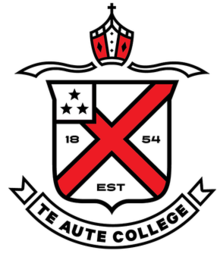Te Aute
| Te Aute College | |
|---|---|
 |
|
| Address | |
| 100 State Highway 2, Pukehou, New Zealand |
|
| Coordinates | 39°49′38″S 176°38′04″E / 39.8273°S 176.6345°ECoordinates: 39°49′38″S 176°38′04″E / 39.8273°S 176.6345°E |
| Information | |
| Type | State Integrated, Boys, Secondary |
| Motto |
Whakatangata Kia Kaha Quit ye, like men be strong |
| Established | 1854 |
| Ministry of Education Institution no. | 232 |
| Principal | Shane Hiha |
| School roll | 141(February 2017) |
| Socio-economic decile | 3G |
| Website | www |
Te Aute College (Māori: Te Kura o Te Aute) is a school in the Hawke's Bay region of New Zealand. It opened in 1854 with twelve pupils under Samuel Williams, an Anglican missionary, and nephew and son-in-law of Bishop William Williams. It has a strong Māori character.
It was built on land provided by Te Whatuiapiti, a hapū of the Ngāti Kahungunu iwi. In 1857, a Deed of Gift transferred the land from Te Whatuiapiti to the Crown, with a request that it be granted to the Bishop of New Zealand and his successors.
After only five years in operation, a fire destroyed much of the college and forced its closure in 1859. Samuel Williams began fundraising for the reconstruction of the college, accumulating £700 by 1870 — in part thanks to financial assistance from an aunt, Catherine Heathcote. Rebuilding began in 1871 and was completed in 1872. The college was reopened in 1872 under John Reynolds as headmaster. It began to grow steadily, with 24 Māori and 3 English boarders in attendance by 1874, and some day pupils.
The college chapel was constructed in 1900, in a design by architect Charles Natusch.
Between 1878 and 1912 Te Aute was led by headmaster John Thornton, who implemented a curriculum developed along the lines of an English grammar school. In 1883 the college was visited by James Henry Pope, the government-appointed inspector of native schools, and received praise for Thornton's curriculum. Pope described the standards reached at Te Aute in mathematics and science as 'equal to those of any secondary school in the country.'
I tried from the very first to raise the standard of the school, and … conceived the idea of preparing Maori boys for the matriculation examination of the New Zealand University ... I saw that the time would come when the Maoris would wish to have their own doctors, their own lawyers, and their own clergymen, and I felt it was only just to the race to provide facilities for their doing so.
...
Wikipedia
